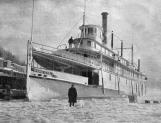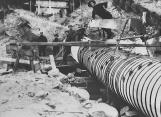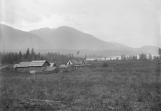1
For the last three years, ice on the Arrow Lakes had been a problem. Sometimes over 2 feet (.61 m) thick, it ravaged the hulls of sternwheelers and tugs, hammering constantly, while at the same time cracking the wooden planks of the paddles. Sometimes the temperature dropped so fast that the boat would get trapped solid, unable to move.It was imperative that the boats get through because this was the only communication for the towns along the lake. There were no roads. Delays were constant and schedules disrupted, leaving camps and towns desperately in need of supplies, and at great risk. A partial remedy against the problem was to attach a large car barge to the front of the sternwheeler; by pushing the barge onto the surface of the ice, its weight would break through making a channel. Reversing the boat the captain would make another charge. It was a very slow process and was the reason delays in deliveries took place.
Towns like Nakusp, Arrowhead and Robson fared the best in these cold winter conditions due to their railway service. Arrowhead was connected with Revelstoke while Nakusp and Robson had train deliveries from Nelson. Places like Comaplix, Burton, Edgewood, and Arrow Park sometimes were completely cut off. Desperate measures would have to be implemented.
3
When towns along the Arrow Lakes became ice locked, all marine transportation systems were immobilized. Groceries, hay, grains, petroleum products, and hardware were a few of the items now not available. People would have been in a perilous situation except that that the ice was thick enough to carry heavy loads; they always had to be prepared for this scenario each year. Long journeys were made on the ice to pick up and deliver mail while social activities continued in the same way. Home remedies were usually sufficient cures for maladies and a midwife took care of the births of babies.5
Spring was always greeted with some enthusiasm. Seeing the ice crack and drift away after such a long winter in 1909, brought new vigor to Nakusp residents. Winter, a period of hibernation where camps closed, farms lay dormant, and folks spent the dark days doing carpenter work on their houses, gave way to showers and emerging buds.7
Fred had been visiting the shipyard at Nakusp almost daily, watching the construction of a new tug called the Whatshan. Having recently extended the texas deck on the Rossland, they were not only finishing up the Whatshan but also preparing for the replacement of the hull on the Rossland. They had started an extension on the texas deck on the Minto as well. The CPR remained a principal employer of the town.9
Stories of railway logging in the Galena Bay area aroused Fred's curiosity. This advancement in conveyance of logs to the lake, although being used at the coast where large stands of timber made the process viable, was not common in the interior. Cool but pleasant weather would make the journey a most enjoyable meeting.11
As far back as 1903, a sawmill of small proportions, was in production at Pingston Creek. Using the water from this source, a flume was installed to drive a pelton wheel, thus eliminating the need for boilers in the operation. On Fred's journey to Galena Bay, the Minto pulled into Pingston; an unscheduled stop. While docked, he learned that the mill, now owned by Rand Gibbons, was being expanded making it necessary to place a much larger pipe on the creek.13
After Fred's arrival in Arrowhead it was necessary to catch the tug, Geo. F. Piper in order to stop at Galena Bay.Galena Bay had missed heavy industrial growth when a railway serving the Lardeau mining area failed to come into being. The terminus of this railway was to be in the Bay at a place called Rosenheim - a spot where a small hotel was erected in anticipation of its completion. Not confident Galena Bay would attract orchardists because of the strong industrial nature of the Arrowhead area, land companies were cool to getting involved there. It was also recognized that the climate was much colder in the north making fruit growing a great risk. The result was most settlers here took pre-emptions or bought crown land.
One of the first permanent settlers was John Olson who got land in 1894. Others who were attracted by the stunning beauty of the glacial mountains southwest of Galena Bay became acquainted with the region while being employed at mills in Arrowhead. John Shaw was one of them and he in turn convinced John Nelson to take up residence in 1904. Then, Nelson persuaded George Ashburner to take up land also.
A strong Russian presence resulted when John Dedosenco obtained property about 1907; he had been working at Arrowhead as well. The Froloffs and Shinkorenkos who had been employed as guards for the Royal family had to flee Russia; after a stay in England, they came to Canada and Galena Bay through their relationships with the Dedosencos.






